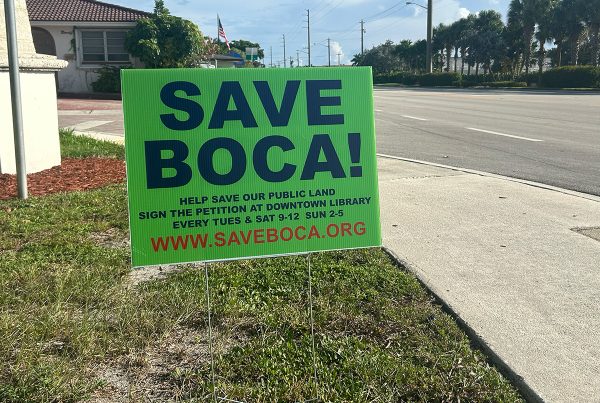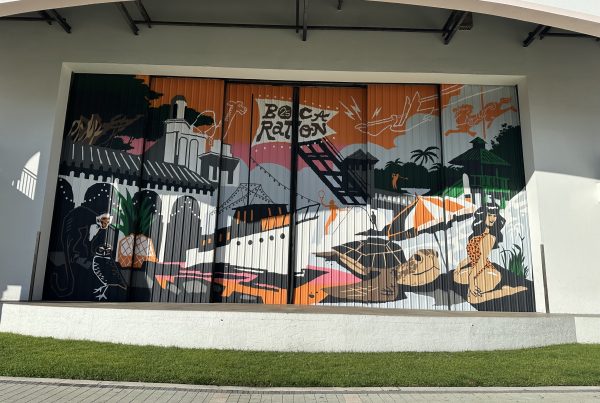Selling out the Ag Reserve?

Delray Marketplace is zippy, modern and fun. But as Palm Beach County Commissioner Steven Abrams correctly puts it, Delray Marketplace “has nothing to do with the ambiance of the Agricultural Reserve Area.”
The complex is west of Florida’s Turnpike, at the intersection of Lyons Road and Atlantic Avenue. It is about seven miles from the other end of Atlantic Avenue that is the heart of downtown Delray Beach. It is about two miles from the Loxahatchee National Wildlife Refuge that is part of the Everglades.
Based strictly on the location and popularity of Delray Marketplace, one could argue that the county commission should abandon any idea of preserving a significant agriculture industry in the Agricultural Reserve—roughly 21,000 acres from Clint Moore Road to Lantana Road between the turnpike and State Road 7—and open the land to more development. That decision, however, would be a bad idea. It would make a unique part of Palm Beach County look more like the worst parts of Broward County and would go against the will of the voters.
But pressure is building to ease the rules on Ag Reserve development. Last December, the county commission told the staff to prepare a “comprehensive workshop” on the reserve. As part of that process, the county held a discussion Monday, to supposedly get input from all involved in decisions about the reserve.
In fact, the discussion told the participants and the public what everyone already knew: some small farmers want more development rights for their land, because at least one major developer is willing to pay the farmers for that land— if the rules for developing the land change.
This pushback started even before the public voted in 1999 to spend $100 million—from a special property tax—on bonds to buy Ag Reserve land and keep it in farming or keep it undeveloped. Developers opposed the referendum, claiming falsely that the bond money should be spent on education. In fact, it couldn’t be spent on education.
At the same time, the county crafted a plan for the Agricultural Reserve that restricts residential development in most cases to one home per five acres and limits the overall number of homes in the reserve. Of the land acquired, the county set aside some for preservation and is leasing back some to farmers, making the county money.
As part of that plan, the county allowed two commercial centers in the reserve. One is on the southeast corner of Lyons Road and Boynton Beach Boulevard. The other is on the northwest corner of Lyons and Atlantic Avenue. It became Delray Marketplace. The county chose the location and size of the commercial developments based on that limited number of homes being built.
The plan has worked fairly well. The public gets a $2.6 billion agricultural industry in the eastern half of the county that, among other things, supplies area restaurateurs who have embraced the farm-to-table concept. Unlike Broward, subdivisions don’t sprawl to the Everglades.
But we can see what is happening. The impetus for this “workshop”—which skeptics believe is designed to give the commission cover to loosen the rules—came from Commissioner Mary Lou Berger. She represents most of the Agricultural Reserve. For two decades, she was an aide to Commissioner Burt Aaronson. I’m told that Aaronson is assisting the farmers who want more development rights.
GL Homes is the big builder in the Ag Reserve. South on Lyons Road from Delray Marketplace, GL Homes is building The Bridges, which also will lack the “ambiance” of the reserve. As a commissioner, Aaronson helped extend Lyons Road, a move that helped GL. The company was a generous contributor to Aaronson’s campaigns and causes, such as the Palm Beach International Film Festival.
That workshop on the Agricultural Reserve is scheduled to take place in January. I will track things to see if the workshop has the “ambiance” of a sellout.
Election notes
Commissioner Abrams—who represents Boca Raton, Delray Beach and most of southeastern Palm Beach County—has not been on a ballot since 2005, when he ran successfully for mayor of Boca Raton. In 2009, former Gov. Charlie Crist appointed Abrams to the seat vacated when Mary McCarty went to prison, and Abrams ran unopposed for a full term in 2010.
This year, Democrat Andy O’Brien is challenging Abrams for the District 4 seat, and by one key metric the race is a rout before anyone votes.
According to the latest financial reports filed with the elections office, O’Brien has raised only about $6,000 and has loaned himself $100,000. Abrams has raised roughly $182,000 while loaning himself $5,000.
Obviously, as an incumbent Abrams has contributions from the many special pleaders who appear before the commission or do business with the county. But for someone who has been campaigning for more than a year, O’Brien hasn’t inspired many people to show that they really believe in his candidacy.
Libraries alive and well
If anyone still doubts the value of public libraries in this digital/eBook age, doubt no more.
The new downtown Boca Raton library opened in June 2013, an event the Great Recession delayed for a decade after voters approved money for construction. For more than five years, downtown patrons were stuck with the spiffy Spanish River Boulevard Library & Community Center, which now serves as a drab venue for early voting.
At one point, there was talk of moving the downtown library to Mizner Park. But the accessibility of the $10 million building shows that the city was right to stick with the Northwest Second Avenue location just north of the old library. Parents bringing one or more young children can get in and out much easier than if they were trying to navigate the Mizner Park garages.
The investment already is paying off. Library Services Manager Ann Nappa says the two libraries had nearly 400,000 visitors during the fiscal year that just ended. The libraries circulated almost 650,000 items, and the programs drew 32,000 people. Those are double-digit increases over 2013, which showed similar gains over 2012. The summer reading programs alone attracted 3,000-plus. “The programs,” Ms. Nappa said in an interview, “are far surpassing projections.”
Delray Beach’s new library on Atlantic Avenue opened in January 2006. Director Alan Kornblau says Delray, like Boca, is seeking to provide a library that is far more than just a place to check out items. Civic groups such as Rotary meet at the library, which Kornblau calls “the living room of a community.”
The digital world, though, is driving changes. “Books are just one of the services we offer,” Kornblau says. With money from the Office Depot Foundation, Delray may create a business center that can provide career counseling for adults. There might be a computer club for students. Florida now requires that the unemployed apply for benefits online. For those who are out of work and can’t afford the service at home, the library is one place to get free Internet access.
Kornblau also makes this point. If digital drives even Barnes & Noble to close its stores in Boca and Boynton Beach, where else but the library will anyone be able to browse for books? He and Nappa don’t want to see it happen. If it does, though, they would be happy to help.
••••••••
You can email Randy Schultz at randy@bocamag.com
For more City Watch blogs, click here.About the Author
Randy Schultz was born in Hartford, Conn., and graduated from the University of Tennessee in 1974. He has lived in South Florida since then, and in Boca Raton since 1985. Schultz spent nearly 40 years in daily journalism at the Miami Herald and Palm Beach Post, most recently as editorial page editor at the Post. His wife, Shelley, is director of The Learning Network at Pine Crest School. His son, an attorney, and daughter-in-law and three grandchildren also live in Boca Raton. His daughter is a veterinarian who lives in Baltimore.







